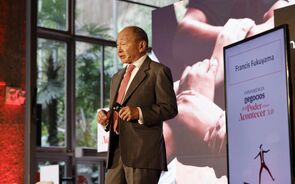AIG: Bailed out again
1 Mensagem
|Página 1 de 1
AIG: Bailed out again
Fed restructures loan and creates 2 programs to rescue insurance giant from bad bets. Treasury buys $40 billion in shares. AIG quarterly loss: $25 billion.
Last Updated: November 10, 2008: 8:48 AM ET
NEW YORK (CNNMoney.com) -- Troubled insurer American International Group got a new, $152.5 billion deal from the federal government on Monday, as the Federal Reserve and Treasury Department made significant changes to the terms of the company's original bailout.
The Fed announced that it will reduce AIG's original $85 billion bridge loan to $60 billion, and it will cut the interest rate by 5.5 percentage points.
In addition, the Treasury will use its special authority under last month's $700 billion bailout law - the so-called Troubled Asset Relief Program - to purchase $40 billion in preferred stock.
The new bailout was worked out between government officials and AIG executives over the weekend. AIG was having difficulty paying back its original bridge loan, which it intended to use to sell off many of its subsidiaries to restore the company to a stable condition. But the credit crisis has proven to be a difficult environment to spin off assets.
"The original bailout was just too onerous for the timing and the cycle," said Andrew Barile, an insurance consultant at Andrew Barile Consulting Corporation. "People also underestimate the time it takes to selloff assets of an insurance company, which takes months and months."
Furthermore, the company's investors continued to demand that the insurer post collateral to back its credit default swap agreements - essentially insurance contracts that AIG had sold to customers worldwide - forcing AIG to borrow more and more from the government. As the company drew down billions, the high interest rate on the original loan became too punitive.
"The Treasury determined AIG was a systemically significant institution," a Treasury official said. "Bringing more equity to the company puts AIG in a better position to dispose of its assets, and it was done to protect the taxpayer."
To keep the company operational, and to ensure that the government gets repaid and can eventually divest from the company, the Fed will also create a new program that will purchase up to $22.5 billion of AIG's troubled mortgage-backed securities. It will also post $30 billion to backstop its credit default swap agreements, taking place of a $37.8 billion lending facility it previously offered the company.
Like many other financial institutions, AIG's mortgage-backed securities have turned into "toxic" balance sheet assets. The government, by purchasing the troubled assets and backstopping its credit default swap agreements, hopes investors will stop requesting collateral increases so the company can focus on spinning off its other companies.
Barile said the bailout will help ease AIG's need to continue to post more collateral, but he said the company will continue to have trouble selling off its subsidiaries. In the current environment, other smaller companies may rather pluck talent away from AIG than assume its unwanted companies.
Financial results: Huge loss
Also on Monday, AIG reported that it lost $24.5 billion, or $9.05 per share, in the third quarter. Excluding one-time charges, AIG lost $9.2 billion, or $3.42 per share, in the three months ended Sept. 8. That compares to a gain of $1.35 per share during the same period a year ago.
AIG Chief Executive Edward Liddy attributed the poor results to "extreme dislocations and volatility in the capital markets" during the quarter.
The giant insurer, which has more than 100,000 employees worldwide, reported revenue of $11.7 billion, down 0.8% from the $11.8 billion the company reported in the third quarter of 2007.
The new bailout marks a stunning turn in the Bush administration's efforts to address the escalating financial crisis. It is likely to stoke calls from those advocating for federal rescue plans for other troubled companies such as automaker General Motors (GM, Fortune 500), which said Friday it was running dangerously low on cash.
"Clearly there are other industries interested in accessing TARP funds, and the Treasury will continue to work on a strategy that will most effectively deploy the remaining funds," Treasury officials said.
The Treasury said its $40 billion capital injection into AIG is not part of the $250 billion that was set aside for equity purchase of banks. Rather, the funds came from an additional $100 billion that President Bush requested. As a result, the transaction's "one-off" status allowed the government to impose more stringent criteria on executive compensation than on banks receiving Treasury assistance.
As part of the new deal announced Monday, Treasury will limit "golden parachutes" and freeze the size of the annual bonus pool for the top 70 company execs. Most banks participating in the Treasury program face compensation curbs on only their top five executives.
AIG has come under fire from lawmakers and state officials for seeking to make big payouts to former executives and planning pricey corporate events after receiving the federal loans.
In mid-September, AIG (AIG, Fortune 500) teetered on collapse, pressured by the effects of the credit crisis. Worried that the company's failure would domino through the rest of the financial system, the government provided AIG with an $85 billion bridge loan. Later, the Fed gave the insurer $37.8 billion line of credit, and made available $20.9 billion in a debt purchasing facility.
The Treasury's $40 billion equity purchase will be used to pay off the $37.8 billion from the Fed.
Liddy, who was installed as CEO after the government's September rescue, said in a statement that the new deal establishes "a durable capital structure" for the company.
"Today's actions send a strong signal to our policyholders, business partners and counterparties that AIG is on the road to recovery," Liddy said.
Um abraço e bons negócios.
Artur Cintra
Artur Cintra
- Mensagens: 3157
- Registado: 17/7/2006 16:09
- Localização: Cascais
1 Mensagem
|Página 1 de 1
Quem está ligado:
Utilizadores a ver este Fórum: Al Beca, Ano nimus, Carlos73, darkreflection, Eduardo R., Ferreiratrade, Kury Yozo, m-m, malakas, Manchini888, mjcsreis, MR32, navaldoc, niceboy, Nuno V, O Magriço, Olhar Leonino, PAULOJOAO, Phil2014, SerCyc, Simplório e 174 visitantes


